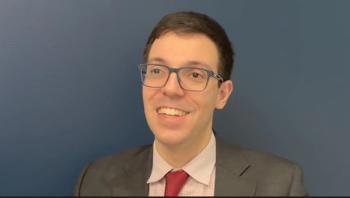
Oncology NEWS International
- Oncology NEWS International Vol 12 No 9
- Volume 12
- Issue 9
Gefitinib Shows Modest Activity Against Recurrent Glioblastoma
This special supplement toOncology News International presents11 reports on novel agents targetingHER1/EGFR, VEGF, and HER2/neu receptorsin the treatment of non–small-cell lung cancer,colorectal cancer, mesothelioma, andglioblastoma. The reports summarizeselected presentations from theAmerican Society of Clinical Oncology (ASCO)39th Annual Meeting and a satellitesymposium held in conjunction with ASCO.
DURHAM, North Carolina-Gefitinib (ZD1839, Iressa) waswell tolerated and showed modest activityagainst glioblastoma in preliminaryresults from a phase II trial presentedby David A. Reardon, MD, ofDuke University Medical Center(ASCO abstract 396).Dr. Reardon, clinical director formedical research at the Brain TumorCenter at Duke, reported that 1 of 52evaluable patients sustained a partialresponse through nine cycles of treat-ment.Another 22 patients had stabledisease, including 8 still on therapywith a mean follow-up of 5.3 months.One patient has been on study for 16months. "He's enjoying 100% performancestatus and excellent quality oflife at this point," Dr. Reardon said.HER1/EGFR Correlations
Gefitinib inhibits the HER1/epidermalgrowth factor receptor (HER1/EGFR) tyrosine kinase. Approved fortreatment of advanced non-small-celllung cancer, gefitinib is being tested inglioblastomas because disruption ofthe EGFR pathway occurs in most ofthese brain tumors.Dr. Reardon said that 40% to 50%of patients in the study had amplifiedwild-type EGFR, and about 50% hadmutated EGFR, according to immunohistochemistryof their tumors. Theinvestigators are correlating responseto tumor EGFR levels, but results werenot ready for release at the time of Dr.Reardon's report."That analysis is ongoing. It's obviouslya critical factor," Dr. Reardonsaid. "We've got an awful lot to learnabout how these drugs are working.We're just scratching the surface."Main Toxicity Was Rash
Among the patients with radiographicallystable disease, two wereremoved from the trial because of toxicityand three because of clinical decline.Dr. Reardon reported the maintoxicity was rash followed by diarrhea.About half the glioblastoma patientshad grade 1 or 2 rash, he said, and 15%had grade 3 or 4.Two other presentations reportedthat severity of rash appeared to correlatewith response to two other novelagents targeting the EGFR pathway:cetuximab (Erbitux) and erlotinib(OSI-774, Tarceva). (See article in thissupplement on page 1.) Rash also wasthe leading side effect in a phase I trialtesting erlotinib in glioma patients (seeprevious report on page 11.)Probably Underdosing
All patients in the ongoing trial, 57to date, entered with first-relapse glioblastoma,histologically confirmed aftersurgery. If patients are on dexamethasoneand/or enzyme-inducing(CYP3A4) agents, the base dose of500 mg of gefitinib daily can be escalatedto 1,000 mg. Treatment cycleslast 4 weeks, and tumor response isassessed by magnetic resonance imaging(MRI) every 8 weeks.Gefitinib may have more activitythan the early results indicate. Dr.Reardon concurred with neurosurgeonAbhijit Guha, MD, of the Universityof Toronto, who suggested theappropriate biological dose might behigher than the trial dose. Dr. Guhadiscussed two studies targeting EGFRinhibitors in brain tumors, praisingthem for exploring pharmokineticsand calling for greater tissue accrual infuture trials.Dr. Reardon told ONI the investigatorsused a conservative dosingschedule because they had little experiencewith the class of agents thatincludes gefitinib and were concernedabout the potential for toxicity. "Wesubsequently learned that although wedid see very encouraging responses ina subset of patients, we were probablysignificantly underdosing due to theintense metabolism that occurs in thesepatients due to the use of enzymeinducing,anticonvulsant drugs," hesaid.Future trials will address the issue."With more effective dosing regimens,I think we will see enhanced activity inthis group of patients," Dr. Reardonpredicted.Defining Optimal Dose
"Our next step will be to define theoptimal biological dose, the safest doseto use, and then look very carefullyand quickly at other agents that canalso affect tumor cells," Dr. Reardonsaid. The investigators are interestedin whether a combination of therapies,conventional chemotherapyagents as well as targeted therapeutics,might be more effective against thecomplex web of signaling pathways intumor cells."There's a lot of redundancy, and Ithink it's naive to expect that one agentis going to be able to eliminate oraffect all of those different signalingpathways," he said. "We're probablygoing to have agents that are impactingdifferent points at different levelsin the signaling cascade before we seethe true benefit," Dr. Reardon concluded.
Articles in this issue
over 22 years ago
Stroke a Late Effect of RT for Medulloblastomaover 22 years ago
Proteomic Patterns Find Ca in Men With High PSAover 22 years ago
Photofrin for Barrett’s Esophagusover 22 years ago
VEGF Inhibitor Extends Survivalover 22 years ago
Gefitinib Fails to Stem Malignant Mesotheliomaover 22 years ago
Trastuzumab Shows Limited Promise in Non-Small-Cell Lung CancerNewsletter
Stay up to date on recent advances in the multidisciplinary approach to cancer.

















































































